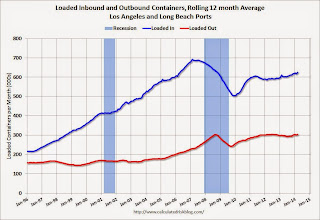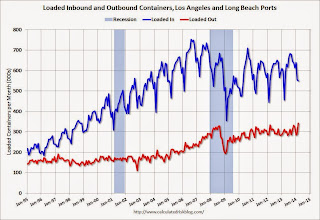by Calculated Risk on 4/17/2014 09:06:00 PM
Thursday, April 17, 2014
Merrill Lynch Reduces Housing Forecast for 2014
From Michelle Meyer at Merrill Lynch: Will April showers bring May flowers?
We have all been waiting for the weather to unleash stronger economic activity, particularly for the housing market. However, the housing data so far have been less than encouraging. We think it will be challenging to realize average housing starts of 1.1 million this year and are therefore trimming our forecast to 1.03 million. Our trajectory through year end is still up, with starts rising 11% from last year, but the rebound is more muted. Slower growth in starts combined with the weaker pace of home sales suggests residential investment will add 0.2pp to GDP growth this year versus our prior forecast of 0.3pp.Merrill has reduced their forecast for housing starts from 1.100 million this year to 1.033 million (still an 11% increase from 2013). They have kept their forecast for new home sales at 515 thousand (close to a 20% gain).
...
It is important to put the recovery in housing construction into perspective. The turn started in early 2011 and gained momentum at the end of 2012. However, last year growth was weak until the bounce at the very end of the year. The question is whether that bounce was a start of a stronger rebound which just got delayed due to the weather or simply noise in the data. We think the truth is somewhere in between and are therefore penciling in an acceleration in starts, but not at the pace we experienced in Q4 of last year.
We have to remember that while this is not a V-shaped trajectory, it is still a recovery. Housing construction will head higher as household formation gradually recovers, capacity constraints around available lots and labor are resolved and credit conditions slowly ease for homebuyers. But this all takes time, and we must be patient as the market finds its new equilibrium.
LA area Port Traffic: Up year-over-year in March, Exports at New High
by Calculated Risk on 4/17/2014 05:59:00 PM
Container traffic gives us an idea about the volume of goods being exported and imported - and possibly some hints about the trade report for March since LA area ports handle about 40% of the nation's container port traffic.
The following graphs are for inbound and outbound traffic at the ports of Los Angeles and Long Beach in TEUs (TEUs: 20-foot equivalent units or 20-foot-long cargo container).
To remove the strong seasonal component for inbound traffic, the first graph shows the rolling 12 month average.
 Click on graph for larger image.
Click on graph for larger image.
On a rolling 12 month basis, inbound traffic was up 1.3% compared to the rolling 12 months ending in February. Outbound traffic was up 0.9% compared to 12 months ending in February.
Inbound traffic has generally been increasing, and outbound traffic has been moving up a little after moving sideways.
The 2nd graph is the monthly data (with a strong seasonal pattern for imports).
 Usually imports peak in the July to October period as retailers import goods for the Christmas holiday, and then decline sharply and bottom in February or March (depending on the timing of the Chinese New Year).
Usually imports peak in the July to October period as retailers import goods for the Christmas holiday, and then decline sharply and bottom in February or March (depending on the timing of the Chinese New Year).
This suggests an increase in trade with Asia in March.
Hotels: Strongest Year since 2000
by Calculated Risk on 4/17/2014 01:12:00 PM
From HotelNewsNow.com: US hotels report strong weekly RevPAR
The U.S. hotel industry posted positive results in the three key performance measurements during the week of 6-12 April 2014, according to data from STR.Note: ADR: Average Daily Rate, RevPAR: Revenue per Available Room. These metrics are now at new highs.
In year-over-year measurements, the industry’s revenue per available room jumped 12.8% to $80.09. Occupancy for the week increased 7.1% to 68.5%. Average daily rate rose 5.3% to finish the week at $116.85.
emphasis added
The 4-week average of the occupancy rate is solidly above the median for 2000-2007, and is at the highest level since 2000.
The following graph shows the seasonal pattern for the hotel occupancy rate using the four week average.
 Click on graph for larger image.
Click on graph for larger image.The red line is for 2014 and black is for 2009 - the worst year since the Great Depression for hotels.
Through April 12th, the 4-week average of the occupancy rate is tracking higher than pre-recession levels.
It looks like 2014 should be a good year for hotels.
Data Source: Smith Travel Research, Courtesy of HotelNewsNow.com
Philly Fed Manufacturing Survey indicated Faster Expansion in April
by Calculated Risk on 4/17/2014 10:29:00 AM
From the Philly Fed: April Manufacturing Survey
Manufacturing activity in the region increased in April, according to firms responding to this month’s Business Outlook Survey. The survey’s broadest indicators for general activity, new orders, shipments, and employment all remained positive and increased from their readings in March. Price pressures remain modest. The surveyʹs indicators of future activity reflected optimism about continued expansion over the next six months, although the indicators have fallen from higher readings in recent months.This was above the consensus forecast of a reading of 9.1 for April.
The survey’s broadest measure of manufacturing conditions, the diffusion index of current activity, increased from a reading of 9.0 in March to 16.6 this month, its highest reading since last September.
The employment index remained positive for the 10th consecutive month and increased 5 points, suggesting overall improvement.
emphasis added
Weekly Initial Unemployment Claims at 304,000; 4-Week average lowest since 2007
by Calculated Risk on 4/17/2014 08:37:00 AM
The DOL reports:
In the week ending April 12, the advance figure for seasonally adjusted initial claims was 304,000, an increase of 2,000 from the previous week's revised level. The previous week's level was revised up by 2,000 from 300,000 to 302,000. The 4-week moving average was 312,000, a decrease of 4,750 from the previous week's revised average. This is the lowest level for this average since October 6, 2007 when it was 302,000.The previous week was revised up from 300,000.
The following graph shows the 4-week moving average of weekly claims since January 2000.
 Click on graph for larger image.
Click on graph for larger image.The dashed line on the graph is the current 4-week average. The four-week average of weekly unemployment claims decreased to 312,000.
This was lower than the consensus forecast of 320,000. The 4-week average is at normal levels for an expansion.


